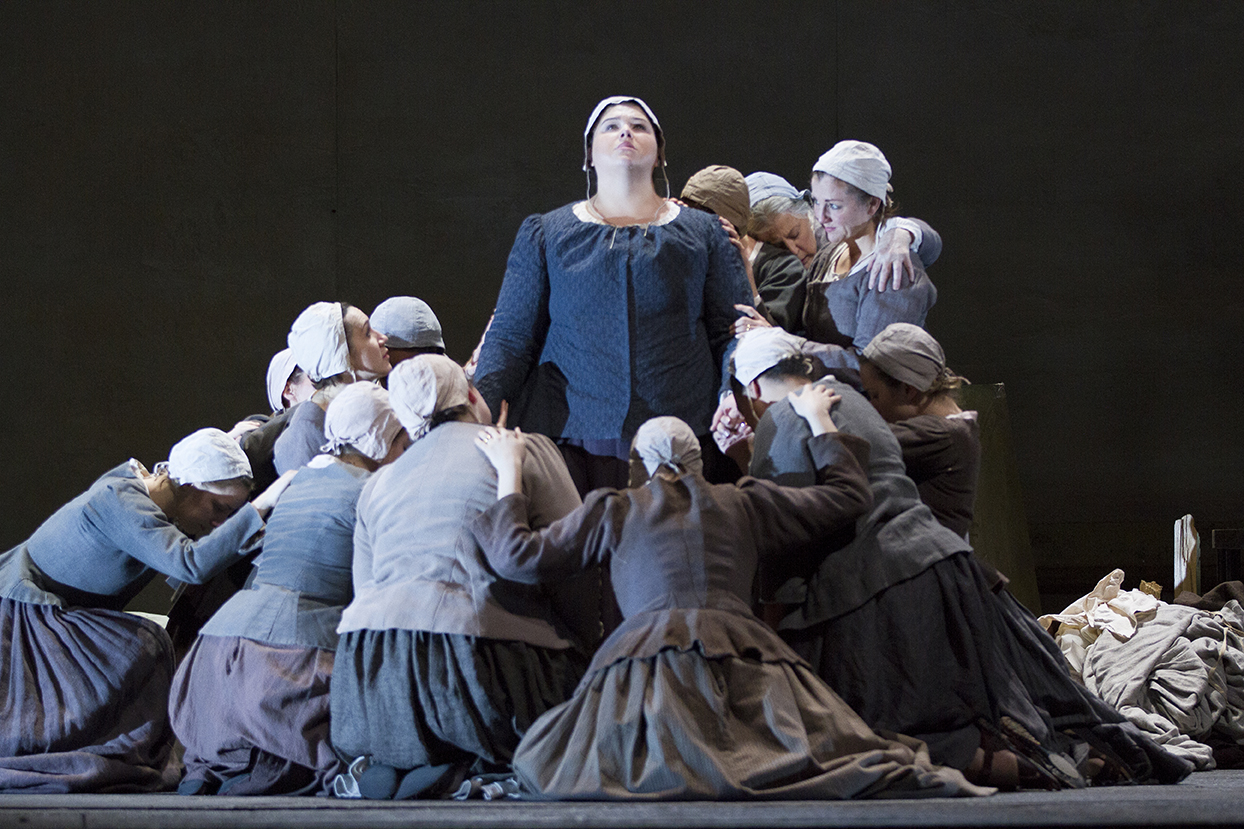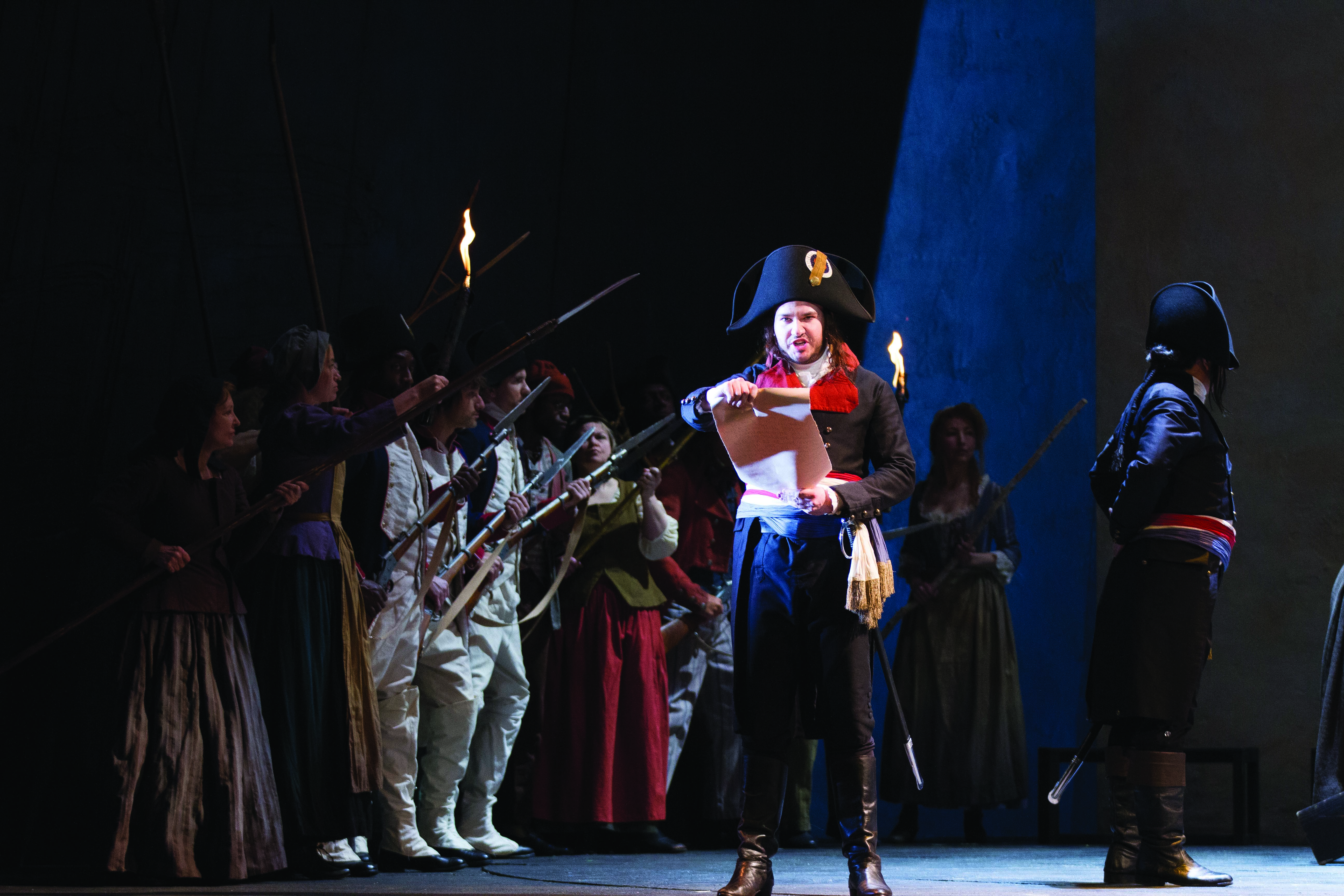Talk To Us
Francis Poulenc’s opera Dialogues of the Carmelites is based on a true story. The 16 nuns at the Carmelite monastery in Compiègne, a city 60 miles northeast of Paris, nearly lived through their ordeal. Though oppressed for years, their arrest, conviction, and execution in Paris on July 17, 1794 came only nine days before Robespierre’s demise brought an end to the Reign of Terror, a particularly brutal offshoot of the larger French Revolution.
It is sobering to realize that the French Revolution lasted about a year and half, shorter than our current pandemic, yet in that time the guillotines were unremitting. There were nearly 10,000 beheadings in those months, a quarter of them in Paris. The stated crime of the Carmelites was insurrection: they refused to renounce their faith within the new secular political order. They were condemned to death by a small but vocal group of zealous revolutionists who themselves lacked the conviction to die for anything, yet the nuns remained true to what they believed.

Having abandoned their convent as instructed by law, the Carmelites were initially arrested because they were wearing their robes, veils, and wimples after religious clothing had been banned. They were dressed that way because it was their washing day and their civilian clothes were drying in the sun, but whatever the nuns said to authorities merely made worse what had long been decided: they could not be allowed to live if the government was to keep control of its insatiably violent political machine.
Like the ancient Roman law that condemned Jesus Christ to a torturous death, the Carmelites were martyred to exert power…but for nine more days. This is part of what makes the Carmelites such a profound experience: in the opera, a selfish political world devoted to control confronts a selfless belief system devoted to service.
Had it not been for a German novelist a century ago, Gertrude von le Fort, we might not have known of the Carmelites at all. An 18th century memoir of Mother Marie (Françoise-Geneviève Philippe) preserved the facts of the time, as she was the only sister to escape execution. In the 1920s, von le Fort saw within the plight of the French Carmelites a parallel to what could happen if Adolf Hitler and his Nazi Party went from fringe to power and, with tragic obviousness, she was among the most prescient writers of her time.
Her 1931 book about the martyrdom of the Carmelites, Die Letzte am Schafott, published as The Song at the Scaffold in English-speaking countries, was popular with millions of Catholics worldwide, and in bringing the story of the nuns back into public consciousness von le Fort sent an unheeded warning to the world about the Nazis. Through a complicated set of circumstances and several other Catholic writers, most especially the influential Georges Bernanos, the story found its way into a movie script and, finally, Poulenc’s opera in the mid-1950s. Bernanos (1888-1948), married to a direct descendent of Joan of Arc’s brother, was a major figure of Catholic literature and philosophy, a world that has largely dissipated into internecine squabbles and new-age aphorisms.
The opera’s most pivotal role is the only character Gertrude von le Fort invented, Blanche de la Force, and Poulenc’s opera revolves around her. She represents, in touching ways, the theological and spiritual conundrums of both von le Fort and Poulenc. Born into a privileged family, Blanche lives like a frightened rabbit, and we learn why. Late in her pregnancy, Blanche’s mother went into premature labor because of a mob attack on her carriage, so fear of violent revolution is coursing through Blanche’s blood. She is sure that within the convent, among the Carmelites, she can find the grace that will replace her fear with peace. Blanche enters holy orders fearfully and, in the most moving of ways, transforms into a courageous heroine in the opera’s famous final moments. The famous ending of Dialogues of the Carmelites is always remembered because its symbolism is so powerful: as each nun approaches the guillotine and we hear its awful sound, there is one less voice to sing their defiant “Salve Regina.” In a shockingly short time, only Blanche’s voice is left. The rest, as Shakespeare’s Hamlet says, is silence.
Dialogues of the Carmelites is a musical marvel. Poulenc didn’t so much compose his characters in the traditional sense as he allowed them to speak across time through him. It is always a surprise to hear so little traditionally religious music within it, yet it is a work of extreme devotion and piety. The puzzle of Poulenc’s opera is the uncompromising severity of its words set against the sensuous color of its music. Its effect is like the art of gay Parisians Pierre et Gilles, whose garishly beautiful religious paintings always somehow bring Poulenc’s music with them. Or think of the colorful depictions of the Christ and the Passion in Spanish churches or in all of the countries where Spanish culture arrived—they create a chasm between what we feel versus what we are told we are supposed to feel. In visual art, much is always made of Jesus and Mary looking more like the artists who painted them than real likenesses, but that is entirely their purpose: we create in art what we need, not what actually was. Similarly, pick out any two consecutive chords in Poulenc’s opera, and you’ll find something out of any 20th century pop song, but meld them together, and this searing and unbearably moving opera is the result—it is a remarkable thing.
“Dialogues”? We don’t go to the opera to hear characters talk, so what does this enigmatic word mean for an expansive art like opera? We think of dialogue as a conversation between people, and Poulenc’s opera has a fair amount of that. But the dialogues of the title describe the inner journey of each character in dialogue with their own voice, their God within. We see this most profoundly in the scene at the deathbed of the Old Prioress. Death should present no fear for her, since by her faith death is the highest purpose of life, the gateway to paradise.

Yet the Old Prioress, after a lifetime of surety and service, is unsure of the one thing for which she has spent a long lifetime in prayer. If faith cannot bring peace at that moment, she wonders, what has it been for? She obsesses on the death agony of Jesus Christ and the fears he must have felt in the Garden of Gethsemane. Blanche finds the Old Prioress’s death unbearable, a fulfillment of every fear and shame she’s ever felt. Every scene of this opera asks us ‘why?’, but the answer never comes—it is always left to us.
As tragic as the story of the Carmelites is, it is also a work celebrating what of their lives was joyous. For the Carmelite nuns, prayer was the sole reason they were together. It was their belief that no one becomes a full person on their own, and this belief in one community gave each of their individual lives meaning. Weren’t they right? It is only through community that we find ourselves, that we discover a standard of conduct, ethics, and morals. We are our tribes.
It is often said that more of history’s wars have been fought over religion than anything else, but is it actually religion that’s being fought over? Is it not simply hunger for power or money, or trying to halt those hungry for them, that makes people kill? It is true that peaceful believers have been scapegoated repeatedly by authoritarians, and the Carmelites were among them. A separation of state and church surely protects both, but this appears to be an eternal struggle solved almost nowhere at any time in history.
We conjure the Carmelites through Poulenc’s extraordinary opera because they conjured us first, and they are trying to tell us something. Careening towards the end of Edward Albee’s 1966 play A Delicate Balance, the leading character, Tobias, describes his early mornings in the house as the first one awake, and his words somehow bring to life the quite different world of the Carmelites:
"It's very strange….to be downstairs, in a room where everyone has been, and is gone…very late, after the heat has gone – and the furnace and the bodies….Each thing stands out in its place….The inn is full – it’s rather…Godlike, if I may presume: to look at it all, reconstruct with such…detachment, see yourself look at it all…play it out again, watch.”
If we listen, detached, to the reconstructed inner voices of the gentle Carmelites, we realize that their dialogues are ultimately not with each other, but with us.